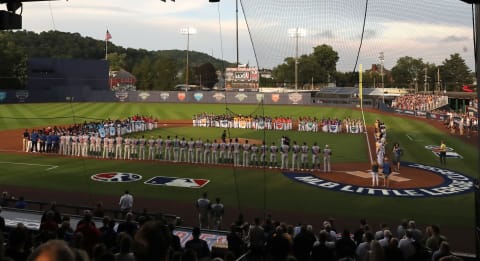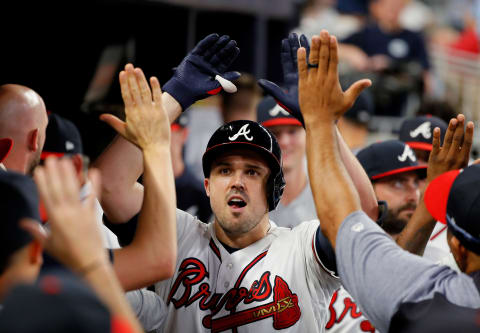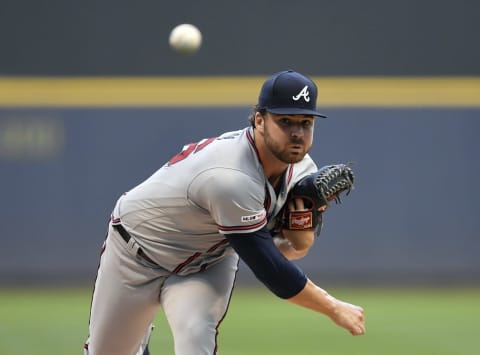Atlanta Braves minors: End of season recap of 2019 Gwinnett Stripers


An end-of-season recap covering all seven Atlanta Braves minor league teams from the 2019 season: Gwinnett Stripers.
In this series, we’re covering each of the seven Atlanta Braves minor league levels, evaluating each club and its top performers.
If you’re interested in jumping to previous recaps:
- 2019 DSL Braves (RK)
- 2019 GCL Braves (RK)
- 2019 Danville Braves (RK+)
- 2019 Rome Braves (A)
- 2019 Florida Fire Frogs (A+)
- 2019 Mississippi Braves (AA)
Today we move on to the Gwinnett Stripers, the Atlanta Braves’ Triple-A club, who ended its season on September 7 in a postseason loss to Columbus.
The team
Gwinnett was the Atlanta Braves organization’s overachievers, winning its division and becoming the only Braves’ minor league club to qualify for the postseason — the Stripers lost in four games to the INT West champs, the Columbus Clippers.
Despite appearing overmatched throughout its 5-game playoff series, Gwinnett’s 2019 season was a success, ending the regular season with an 80-59 record — five games ahead of the IL South’s second-place team.
It would be an understatement to say that the Triple-A level changed from last season to 2019. Additionally, the same thing could be said about the Stripers. The league turned into a video game on offense:
Overall Triple-A
- 2019: 5.16 R/G, 2,440 HR, .787 OPS
- 2018: 4.16 R/G, 1,555 HR, .709 OPS
Gwinnett
- 2019: 5.62 R/G, 254 HR, .809 OPS
- 2018: 4.20 R/G, 101 HR, .699 OPS
The over 200-percent increase in runs per game from the new rabid baseball boosted the Stripers’ offense tremendously. Gwinnett finished third in the International League in runs per game and fourth in home runs and OPS. Slugging 1.82 homers per game will do that.
You know what else it will do…? Break records.
On July 27 (!), catcher Alex Jackson belted a homer against Columbus for the Stripers 162nd long ball of the 2019 season — breaking the single-season home run record set by the Richmond Braves back in 1993.
Who knew that a month-in-a-half later Gwinnett would finish with 91 more than the previous record. Absolutely unreal.
The Stripers also finished the season with above-average slash stats (.269/.348/.461) — good for 6th-place in batting average, 5th in OBP, and 4th in SLG in the 14-team league.
All of that slugging came with a fair share of swings and misses for Gwinnett, as only three other teams finished with more total strikeouts (1,265 / 26.8 K%). However, the Stripers were among the best at drawing walks too (4th), running a healthy walk-rate of 10.5%.
Given the crazy offensive environment in 2019, the organization’s most talented pitching prospects somehow found a way to succeed.
Gwinnett led the league in ERA, finishing with a 4.29 ERA in a league where a 4.90 mark was average. The Stripers found a way to maintain control on the mound, allowing the second-fewest hits and home runs, all while striking out 8.9 batters per nine — good for 6th-worst.
The Stripers finished the year with 449 walks (3rd-fewest) and on a rate basis held a solid mark of 3.31 BB/9. Even better, Gwinnett’s pitchers allowed the fewest total home runs in 2019, surrendering 134 long balls — 69 fewer than the team with the most allowed.
Overall, the Stripers were an elite team on the mound, and given the fact that the Gwinnett roster finished the season as the youngest team in the league, it’s pretty impressive how the staff not only held its own but led in numerous categories.
The average age of a player in the International League in 2019 was 26.2 years-old. Gwinnett’s roster averaged just 24.8 years-old.

The top hitters
Four Gwinnett batters finished with at least 20 home runs in 2019, with one tallying 19.
- OF, Adam Duvall: 32 HR
- C, Alex Jackson: 28 HR
- OF, Rafael Ortega: 21 HR
- 2B, Andres Blanco: 20 HR
Duvall led the team with 32 home runs (2nd in the league) and 93 RBI (also 2nd-most in the league), all while playing in fewer games than five other players in the lineup.
The 30-year-old slugger slashed .266/.364/.602 and slapped 20 doubles while playing in 101 games with the Triple-A team. He also hit 8 homers in 35 games with the Atlanta Braves, as the major league team called for his services when Nick Markakis fractured his wrist.
Jackson enjoyed 2019’s new ball, as he broke out with a career-high in homers (28) and SLG% (.533). Despite his gains in power, Jackson still struggled to maintain a decent average (.229), mostly from an unsightly strikeout rate (38.5 K%).
The all-around hitter of the year for Gwinnett undoubtedly goes to Ortega, who not only slugged 21 homers but also hit 34 doubles (team-high and 4th in the IL) and slashed .285/.373/.524 on his way to the best season of his 12-year pro career.
Ortega finished third in the INT League with 83 runs scored, while also coming in at 13th in total hits (123). Only six other INT League players tallied more than his 226 total bases.
While he’s sadly no longer part of the Atlanta Braves organization, outfielder Travis Demeritte was right with Ortega when it came to doing it all for the Stripers. Demeritte was involved in a trade with the Detroit Tigers in July — the deal that brought reliever Shane Greene to the Atlanta Braves.
The 24-year-old Demeritte played in 96 games and finished second on the team in OPS (.944) amongst Gwinnett hitters that played at least 50 games in 2019. Demeritte also slapped 28 doubles — second only to Oretga.
Blanco, another veteran player (35-years-old), never hit more than 10 home runs in his 17 years of professional baseball. In 2019, Blanco hit 19 long balls while maintaining a .264 batting average.
While Austin Riley only played in 44 games for Gwinnett in 2019, the 22-year-old managed to hit 15 home runs (6th on the team) and 13 doubles. His .992 OPS would’ve led the team and the league if he could’ve accrued enough plate appearances.
While a Striper, Riley also showed excellent plate discipline, running above average K/BB rates of 22.4 K% and 11.4 BB%.
Infielders Pedro Florimon, Jack Lopez, and Sean Kazmar Jr. all had great seasons as well, as all three hit 10+ home runs and batted .265+.
Kazmar Jr., 35-years-old, even picked up his 1,500th hit in 2019.
Congratulations to Sean Kazmar Jr. on his 1500th minor league hit! pic.twitter.com/hZSIAxuSAM
— Gwinnett Stripers (@GoStripers) June 6, 2019
The minor league veteran now has 1,558 hits in 16 minor league seasons.
Lopez filled in for Riley and played excellent defense at third base while also playing at other spots in the infield. Lopez, 26-years-old, played in 96 games with Gwinnett, hit .273, and belted 12 homers with 16 doubles. He finished with 9 stolen bases on the year.
Overall, the 2019 Gwinnett lineup was about as good as it gets. In a season where the entire league experienced a massive influx in offense, the Stripers not only held it’s own but led the way.

The top pitchers
The International League leader in ERA (3.42), Gwinnett’s Bryse Wilson had another solid year on the mound. The 21-year-old finished the season with the team-high in strikeouts (118) — good for the 7th-most punchouts in the INT League.
Wilson started the 2019 campaign with the Atlanta Braves, making a start on March 30 for the big league team. However, he got roughed up and needed 73 pitches to get through 3.1 innings (4 ER).
The former fourth-round pick made a one-inning appearance at the end of April versus the Rockies before going down to Gwinnett for over a month. Wilson made a start for the Atlanta Braves once in June, twice in July, and once in September.
Altogether, Wilson accrued 20 innings pitched in the majors, allowing 20 hits and 5 home runs — good for a 7.20 ERA.
With Gwinnett, Wilson went 10-7 in 21 starts, striking out 8.8 batters per nine while walking less than two per nine (1.9 BB/9). He’s currently in the Atlanta Braves bullpen.
Second on the team in strikeouts (116) was 23-year-old Kyle Wright, who made 21 starts for Gwinnett and finished with a 4.17 ERA with the Stripers. Wright also made four starts and three relief appearances for the Atlanta Braves.
Like Wilson, Wright is currently in the major league bullpen trying to make a case to be on the postseason roster (8.69 ERA in the majors this season).
Wright’s 2019 season didn’t go exactly as we all expected, but overall it was still a nice year for the Huntsville, Ala. native. His run prevention could’ve been better, but Wright was just fine when it came to strikeouts and limiting walks (9.3 K/9, 2.8 BB/9).
Home runs were a bit of a problem, as Wright surrendered 13 long balls in his 112.1 innings-pitched in Triple-A (he gave up 4 homers in just 19.2 IP with the Braves).
Kolby Allard finished with an identical ERA as Wright, making 20 starts for Gwinnett before being traded in July as part of a deal with the Texas Rangers, bringing reliever Chris Martin to the Atlanta Braves (Allard has been terrific with the Rangers since then, by the way).
Allard was still a bit underwhelming when it came to strikeouts in 2019 (8.0 K/9), and he also had a home run problem, allowing 15 homers while with Gwinnett, but he maintained a strong walk-rate (2.9 BB/9) and ultimately pitched rather well being in such an offensive environment.
Twenty-four-year-old Patrick Weigel (#20 on THE BOARD), who was coming back from Tommy John surgery, made a huge statement this season. Weigel was strong, throwing 63.1 innings for the Stripers (15.2 innings for Mississippi) and maintaining a 2.98 ERA in his 21 games (11 starts / 10 relief appearances) in Triple-A.
The only quibble with Weigel was his poor walk rates. In Mississippi, the righty finished with 5.5 BB/9 in 7 starts, while in Gwinnett Weigel ended the season with 4.5 per nine.
Thomas Burrows and Wes Parsons were the most effective Gwinnett relievers of the regulars. Burrows made 27 appearances and held a 4.75 ERA while Parsons also pitched in 27 games, but was better at preventing runs (2.86 ERA).
In fact, Parsons surrendered just one home run in the 56.2 innings he pitched while with the Stripers. The 27-year-old also accrued 15.1 innings with the Atlanta Braves (17 relief appearances), pitching to a strong 3.52 ERA.
Parson’s walk-rate jumped substantially when he moved up to the big leagues in 2019, going from 3.3 BB/9 to 7.6 BB/9.
When the Stripers needed a reliever to come in and shut things down or hold a lead, 31-year-old Grant Dayton was the man. Dayton also made 12 appearances in the majors in 2019 (2.61 ERA).
But in Gwinnett, boy was Dayton dominant. Over 26.2 innings pitched, he struck out 41 batters and walked just one — good for gaudy K/BB rates of 13.8 K/9 and 1.4 BB/9. He maintained those high rates while with the Atlanta Braves as well (12.2 / 2.6).
Jose Rafael De Paula and Ben Rowen finished Nos. 1 and 2 in appearances for the Stripers, with each pitching in 33 and 31 games, respectively. Paula struggled a bit, walking 5.7 batters per nine, but he was still able to maintain a decent 4.35 ERA in his 39.1 innings pitched.
Rowen, more of a pitch-to-contact type, did well with Gwinnett, as he held a 3.48 ERA in 77.2 innings pitched. In his age-30 season, Rowen allowed just 4 homers and 11 walks (1.3 BB/9) while striking out 58 batters (6.7 K/9).

The verdict
I have to say, Gwinnett and Mississippi were by far the two most exciting Atlanta Braves minor league teams to watch — the Stripers were especially fun once Cristian Pache and Drew Waters were added to the lineup.
The numbers speak for themselves as to how talented the 2019 Gwinnett roster was and will be in 2020.
What’s amazing is that guys like Pache and Waters probably don’t have near as long as we once thought. Those two will most definitely be in Florida (2020 Spring Training) come February and it’s not that far fetched to expect one of them (if not both) to earn themselves a cup of coffee come next September.
Other hitters, like Adam Duvall and Rafael Ortega, are much older and may not be included in the Braves distant future. However, I believe at least one of those two will be back in 2020.
Duvall, who makes $2.875 million this season, could be a bounce-back player the Braves attempt to move in the offseason. Although, his strong performance in 2019 may have won him a bench-role for next season.
On the pitching side, there’s a plethora of options as well as guys that maybe took a step back and need to show more in 2020.
- Jeremy Walker may have earned himself a real close look in 2020. In 32 minor league games in 2019, Walker pitched to a 2.88 ERA with 9.1 K/9 and 1.2 BB/9 — so dominant that he’s now in the Atlanta Braves bullpen and has been for a while.
- Touki Toussaint, who I didn’t mention in the previous slide, had a rough 2019 season. The Braves will need to decide what’s next for him.
- Kyle Wright and Bryse Wilson didn’t necessarily take a step back in 2019, but they also didn’t exactly meet expectations. I’m not sure either ‘needs’ more Triple-A innings, but as of right now I’m not sure where they fit in the major league rotation.
Twenty-twenty will be a big season for starting pitcher Ian Anderson, as this will be his first full season in Triple-A. After absolutely dominating in Mississippi, Anderson struggled a bit with the Stripers (admittedly, in an extremely small sample of innings).
I’m also interested in how far Philip Pfeifer can go. He pitched his way from Florida to Gwinnett in 2019. What’s in store for him in 2020?
Also, Patrick Weigel will be two years removed from TJ surgery and should be a full-go in 2020. Weigel is a former 7th round pick (2015) and has some serious upside just like the rest of these prospects.
Finally, there’s of course what I call the next wave of pitchers (not counting potential relievers). Guys like Kyle Muller and Tucker Davidson, or even Jasseel De La Cruz.
There are just so many talented players in this system, and so much that’s left to figure out. I’m not naive enough to think that all of these guys will remain with the Atlanta Braves. Some may even be gone by this time next year.
But there’s a reason the Atlanta Braves organization is one of the best when it comes to farm systems. For every young player that regresses there’s two more that breaks out.
Next. NLDS rotation options. dark
Who do you think is set up to have a big year in 2020? Which Braves prospect impressed you the most in 2019? Share your thoughts below in the comments section.